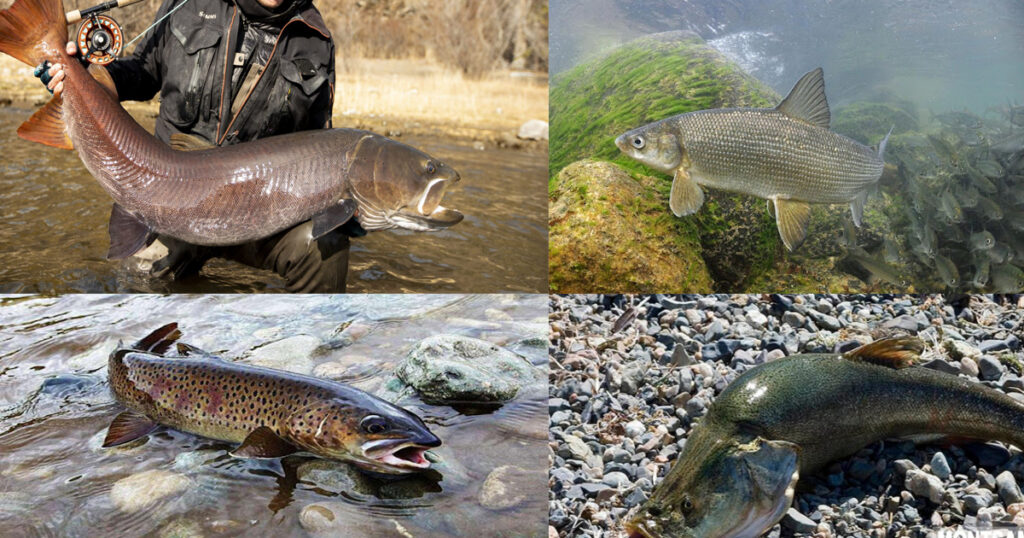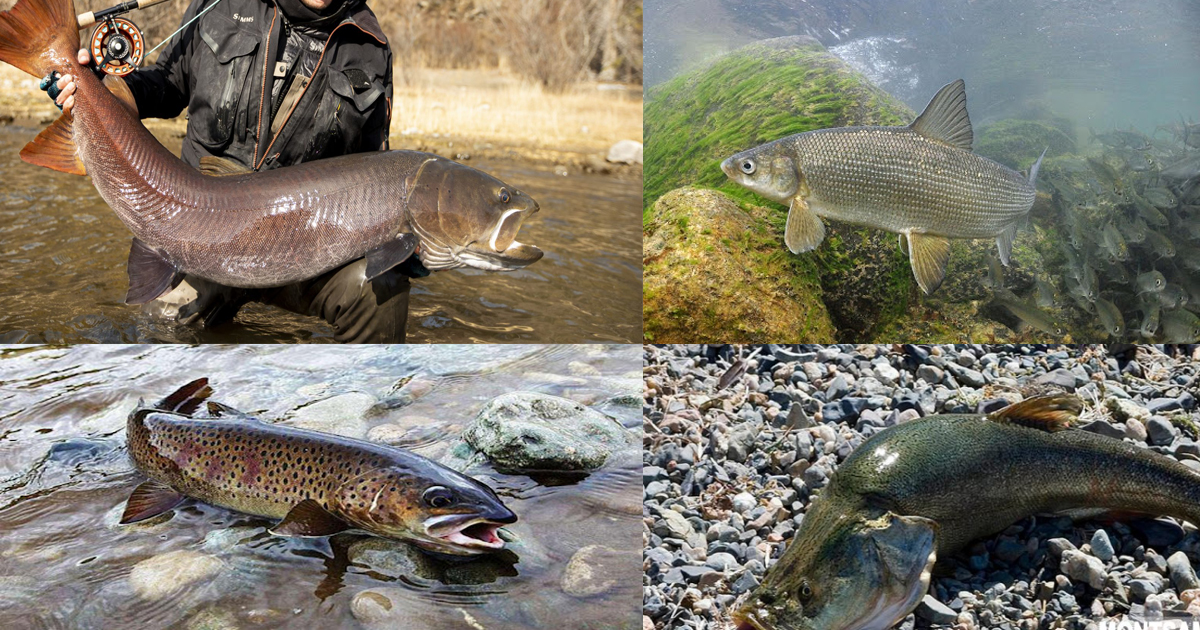Tourists visiting Mongolian fishes in rivers and lakes, especially those interested in fish angelers and sport fishing, are often eager to catch the country’s largest and rarest freshwater fish. Many of these species are endangered or endemic to Mongolia’s remote rivers and lakes, making the fishing experience not only a sporting challenge but also a unique journey through untouched nature.
Reaching the habitats of these prized fish often involves long and difficult travel through rugged landscapes, which adds to the thrill for adventure-seeking anglers. Below are four of the most iconic fish that draw sport fishermen from around the world to Mongolia.

The Taimen – The King of Mongolian Fish
The Taimen (Hucho taimen) is considered the king of Mongolian fish and is the largest member of the salmonid family. It is widely recognized as an indicator species of freshwater ecosystems. Because the Taimen preys primarily on weak or diseased aquatic animals, its presence in a healthy state often signifies that the water quality, aquatic biodiversity, and overall ecological balance are in good condition.
The Taimen has a slender, elongated body with a narrow head and large mouth, featuring symmetrical upper and lower jaws. Its back is dark brown, and it has an adipose fin above the tail fin. All its fins are reddish in color. During spawning season, its body takes on a striking copper-red hue.
Taimen reach sexual maturity at 6 to 7 years of age and can live more than 30 years. As they grow larger, they tend to migrate to deeper waters. Juvenile Taimen feed on various aquatic invertebrates, but by the age of four, they become carnivorous—preying on smaller fish such as lenok (Brachymystax lenok), dace, minnows, grayling, and occasionally small mammals.
In late May to early June, when the river ice begins to thaw, Taimen gather at spawning grounds. A single female may lay up to 14,000 eggs, yet only one or two are likely to survive through natural selection. Taimen in the tributaries of the Selenge River, the lakes of the Darkhad Valley, and the Buir Lake basin typically measure between 65 to 130 centimeters in length and weigh 30 to 50 kilograms. In the Yeröö River basin, some Taimen grow up to 170 centimeters long and can weigh between 40 and 60 kilograms.
They build nests in gravel beds in calm parts of rivers, deposit their eggs, and then leave them. The eggs rely on the yolk sac for nutrition until they hatch. Taimen do not feed during spawning season, consume very little during summer, and increase their intake significantly in autumn.
This species primarily inhabits deep sections of high-altitude, fast-flowing, cold, and clear rivers rich in oxygen. Nutritionally, Taimen meat contains 20.6% protein, 6.9% fat, and 1.3% minerals.
In recent years, Taimen have become increasingly rare, leading to the emergence of several conservation-focused volunteer organizations. In Mongolia, sport fishing for Taimen has become a popular tourism activity. According to regulations issued by the Ministry of Environment and Tourism, foreign tourists must obtain a special permit and pay a fee to fish for Taimen legally.
Identification Characteristics
It has a robust and elongated body. The mouth is wide and flat, with a strong jaw and palate equipped with solid teeth. A small, round, dark spot is present on the top of the head. The body surface is marked with crescent-shaped black spots. The back is brownish-dark, the sides are coppery reddish-brown, and the belly is silvery white. It has a dorsal adipose fin. During the breeding season, the pelvic and caudal fins turn reddish-pink. The upper jaw is elongated, extending past the eyes. Juveniles display 7 to 10 dark transverse stripes along the sides of the body.
Distribution and Habitat
This species is distributed from the Ob, Lena, and Kama rivers, across the Sea of Okhotsk to the Amur River basin. In Mongolia, it inhabits large tributaries of the Selenge River, some lakes of the Darkhad Depression, as well as the Shishged, Khug, Delgermörön, Eg, Onon, Kherlen, and Khalkh rivers, and Lake Buir.
Ecological Characteristics
Adapted to live in cold, high-altitude lakes and fast-flowing rivers. It overwinters and spends spring in deep river bends and pools. Juveniles feed on various aquatic invertebrates, while after the age of four, it becomes carnivorous, preying on small fish, small mammals, and the chicks or nestlings of birds. In the Darkhad Depression and river confluences, individuals aged 22–34 years were recorded to be 1.2–1.5 meters long and weighed 22–45 kg. However, between 1979–1991, individuals ranged from 33.6–79.2 cm in length and 430–4200 grams in weight. It is a long-lived species, typically living over 40 years. Sexual maturity is reached at age 7. Spawning takes place in early May, during the ice drift, when the fish gather at their breeding grounds. Eggs are laid in the upper parts of rivers with gravel bottoms and fast currents. A single female can produce between 8,375 and 25,380 eggs.
Population and Threats
The population has significantly declined throughout its habitat due to the destruction of deep overwintering and springing pools, water pollution from gold mining and other activities, and illegal fishing.
Zeveg Fish (Siberian dace)
The Zeveg fish belongs to the Cyprinidae family, which is widely distributed in the Northern Hemisphere and includes freshwater and migratory species. In Mongolia, there are two species of this family found.
Distribution
Zeveg fish are distinct in shape and are naturally distributed from central Siberia eastward to Eastern Siberia, the Russian Far East, northern China and Mongolia, and the western parts of Korea. In Mongolia, they are found in the Selenge River and its tributaries, the lakes of the Darkhad Depression, Terkhiin Tsagaan Lake, and the Onon, Khalkh, and Kherlen Rivers.
Physical characteristics
Zeveg fish reach sexual maturity at 5–8 years of age, at which time they measure 39–42 cm in length and weigh 600–800 grams. Female fish mature about one year later than males. Spawning migrations begin in April–May. The preferred spawning grounds are fast-flowing river sections with gravelly or stony bottoms and currents of 0.2–0.5 m/s. The water temperature during spawning ranges between 6–12°C. A female Zeveg lays between 3,000–7,500 eggs and is considered a slow-growing species. The largest specimens can reach up to 70 cm in length and weigh up to 6 kg. In some cases, individuals can grow as long as 1 meter, depending on the ecological conditions of the river or lake in which they live.
Diet
Zeveg fish are omnivorous, and their diet varies greatly. They feed on small fish, insects and their larvae, algae, water fleas, stoneflies, mosquitoes, and other small aquatic organisms.
Shar Sugas Fish (Yellow Sucker Fish)
This fish has a long and slender body. Its back appears shiny with green, brown-gray, and golden-yellow hues, while its sides are mostly silvery. It resembles the dog sucker fish, but its lower jaw is smaller. The head makes up about one-third of the body length. The scales are small, so they do not fully cover the belly area. The body length reaches up to 65 cm, and its weight can be up to 2.3 kg. The average weight is about 1.2 kg.
The yellow sucker fish is an indigenous species of the closed basins in Central Asia. It lives in Khuvsgul Lake, located at the foot of the Jargalant Mountain in the Khangai Range. In winter, it inhabits the deep parts of the lake, and in summer, it spreads along the shore zones to feed. The yellow sucker reaches about 17-19 cm in length at 7-8 years old, after which it begins to spawn. From early May to August, when the water temperature reaches 12-18 °C, it lays its eggs in patches on sand, gravel, and sometimes on plants. Depending on the size of the female, it produces on average 12,000 to 29,000 eggs. The species is long-lived, with an average lifespan of up to 36 years. The main diet of the yellow sucker consists of algae. It also feeds on aquatic plants, floating animals, and bottom-dwelling organisms. Its meat quality is similar to that of the dog sucker fish.
Darkhad White Fish
In the northern region of Khovsgol province, in the Darhad valley, there is a beautiful natural area composed of a network of 36 rivers and about 300 lakes. It is home to the famous Darhad Whitefish. The whitefish lives at depths of 3 to 14 meters in the lakes. In June, the younger fish spread out to the warmer shallow areas, while the mature adults stay in the deeper parts of the lake. During the spawning season, they migrate to the rivers flowing into the lakes and begin spawning from the first half of August until mid-September.
The whitefish becomes capable of reproduction from the age of 4 to 5 years. They feed on floating and bottom-dwelling aquatic animals. During the planned economy period, a few professional fishermen caught about 100 tons of fish annually. One net could catch between 2 and 11 tons, indicating a very large stock. Nowadays, however, fishermen only catch a few fish even after setting nets for three days. Overfishing by profit-seeking fishermen, as well as the increase of predatory birds called Black-headed Gulls feeding on the whitefish during its spawning period, have contributed to the decline of this fish by 30 to 90 tons.
The meat of the whitefish contains 19% protein, 28% fat, and 5% minerals. During the spring and autumn seasons, consuming soup made from whitefish is highly beneficial for replenishing vitamin deficiencies, relieving fatigue, treating women’s illnesses, urinary restrictions, and edema. The meat is usually cooked and eaten after boiling in soup.
